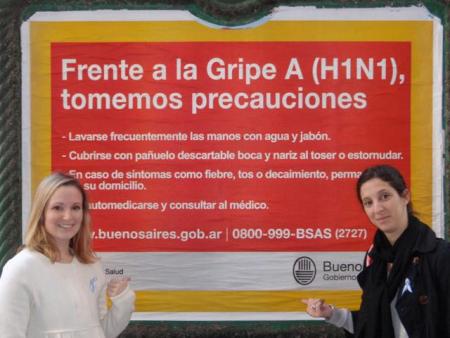Christin Foster's South American swine flu journal, part three: Catch-22
The following is the third and concluding chapter of FSU student Christin Foster's experience with swine flu during her recent trip to South America. The series wraps tomorrow with some final observations.
 Argentina’s Catch-22
Argentina’s Catch-22
Malaly, my friend in Buenos Aires (in photo, standing on the right), came down with the swine flu at the same time that I did. She experienced the same symptoms I did and yet received a totally different treatment in Argentina. As such, I believe that Argentina serves as an excellent example of what not to do during a pandemic.
The Kirschner government had an inefficient approach to the swine flu. At the time when Malaly and many other Argentines were becoming sick, the government bought all of the Tamiflu and would not distribute it to sick people unless a clinical test came back positive for the swine flu. This caused great strain on doctors and medical facilities. Additionally, at this point in time, it took two weeks to get the results back on a swine flu test and so by the time one was clinically diagnosed with it, he was either completely healed or dead.
Therefore, despite Malaly’s high fever and symptoms, she was given a test for swine flu and then sent home with prescription painkillers and antibiotics to prevent pneumonia. That was all the doctor could do. She too was placed in quarantine for a week.
The Chile program ended and I returned to Argentina for vacation the day that Malaly was released from quarantine. She was scheduled to start exams the next day at the university. She stayed up all night studying only to be sent home from the university the next morning. The school administrators told her that she was not allowed to set foot in the university until she had an official note saying that she was in good health to return to school. She drove back home, picked me up and we drove to what I can best explain to be a Ministry of Health in Education building.
Malaly spoke to the doctor at the Ministry to ask for a note of good health to be allowed back in school. The doctor refused to give her the note because Malaly had not been given Tamiflu. Because she had not been given Tamiflu, Malaly had not “legally” had the swine flu and therefore he could not legally write her a note of good health. However, she was not given Tamiflu because the government had control of the antiviral drug and she still had yet to have her swine flu test results back. It was a swine flu catch-22. Malaly returned home with no note and with no way of taking her finals at the university.
The television stations in Buenos Aires were flooded with news of the swine flu and of the Congressional elections that took place on June 29. The Kirschner government was greatly criticized for its reaction to the pandemic, among other things, and lost significantly in the elections. Former President and Senator Nestor Kirschner, President Cristina Kirschner’s husband, stepped down as head of the political party after the devastating loss at the polls.
The swine flu was also a big topic of interest. The country was still in the process of figuring out how to handle the illness and it did so publicly. There was talk for days of closing the schools early for winter holidays. The news channels also kept a live tally of the number of casualties from the swine flu. Every time you would look up at the TV screen the tally would have increased. Entire towns were shut down to try to stop the spread. Less and less people were out in the streets of Buenos Aires and Malaly’s friends were often too scared to leave their homes. There were billboards on almost every street in Buenos Aires instructing people on how to stay protected from the swine flu. The schools were eventually closed. It seemed as though the black plague was going through Argentina and not just a strain of the flu.
Instead of decreasing the spread of disease and increasing the availability of medical care, the Argentine government created a state of fear and panic. Not only did the news scare the Argentine public, and rightfully so with a live death tally, but the government also mismanaged the medications and disrupted an otherwise effective system of medical care. It was a complete contrast to the experience I had in Chile and I felt fortunate for being treated in Santiago and not Buenos Aires.
Swine Flu Survivor
Having the swine flu in South America was an incredible experience. I learned a lot about public health from observing first hand the contrast between how the pandemic was handled in Chile and in Argentina. Fortunately, regardless of the difference in treatment, both Malaly and I healed just fine and are now back to life as usual.

Reader Comments